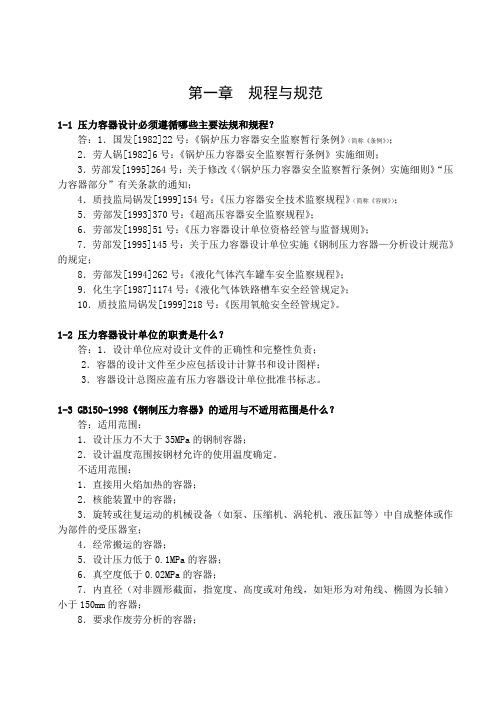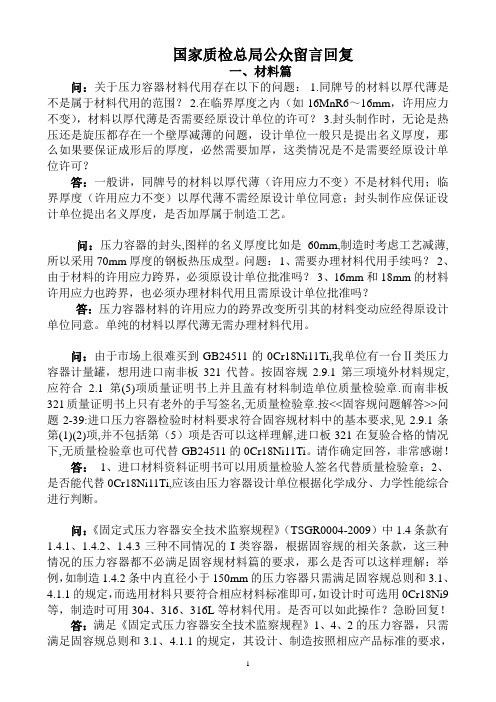BSEN13445-4-2009中文版无燃烧压力容器的制造
- 格式:pdf
- 大小:1.34 MB
- 文档页数:54


第一章规程与规范1-1 压力容器设计必须遵循哪些主要法规和规程?答:1.国发[1982]22号:《锅炉压力容器安全监察暂行条例》(简称《条例》);2.劳人锅[1982]6号:《锅炉压力容器安全监察暂行条例》实施细则;3.劳部发[1995]264号:关于修改《〈锅炉压力容器安全监察暂行条例〉实施细则》“压力容器部分”有关条款的通知;4.质技监局锅发[1999]154号:《压力容器安全技术监察规程》(简称《容规》);5.劳部发[1993]370号:《超高压容器安全监察规程》;6.劳部发[1998]51号:《压力容器设计单位资格经管与监督规则》;7.劳部发[1995]145号:关于压力容器设计单位实施《钢制压力容器—分析设计规范》的规定;8.劳部发[1994]262号:《液化气体汽车罐车安全监察规程》;9.化生字[1987]1174号:《液化气体铁路槽车安全经管规定》;10.质技监局锅发[1999]218号:《医用氧舱安全经管规定》。
1-2 压力容器设计单位的职责是什么?答:1.设计单位应对设计文件的正确性和完整性负责;2.容器的设计文件至少应包括设计计算书和设计图样;3.容器设计总图应盖有压力容器设计单位批准书标志。
1-3 GB150-1998《钢制压力容器》的适用与不适用范围是什么?答:适用范围:1.设计压力不大于35MPa的钢制容器;2.设计温度范围按钢材允许的使用温度确定。
不适用范围:1.直接用火焰加热的容器;2.核能装置中的容器;3.旋转或往复运动的机械设备(如泵、压缩机、涡轮机、液压缸等)中自成整体或作为部件的受压器室;4.经常搬运的容器;5.设计压力低于0.1MPa的容器;6.真空度低于0.02MPa的容器;7.内直径(对非圆形截面,指宽度、高度或对角线,如矩形为对角线、椭圆为长轴)小于150mm的容器;8.要求作废劳分析的容器;9.已有其他行业规范的容器,诸如制冷、制糖、造纸、饮料等行业中的某些专用容器和搪玻璃容器。


国家质检总局公众留言回复一、材料篇问:关于压力容器材料代用存在以下的问题: 1.同牌号的材料以厚代薄是不是属于材料代用的范围? 2.在临界厚度之内(如16MnR6~16mm,许用应力不变),材料以厚代薄是否需要经原设计单位的许可? 3.封头制作时,无论是热压还是旋压都存在一个壁厚减薄的问题,设计单位一般只是提出名义厚度,那么如果要保证成形后的厚度,必然需要加厚,这类情况是不是需要经原设计单位许可?答:一般讲,同牌号的材料以厚代薄(许用应力不变)不是材料代用;临界厚度(许用应力不变)以厚代薄不需经原设计单位同意;封头制作应保证设计单位提出名义厚度,是否加厚属于制造工艺。
问:压力容器的封头,图样的名义厚度比如是60mm,制造时考虑工艺减薄,所以采用70mm厚度的钢板热压成型。
问题: 1、需要办理材料代用手续吗? 2、由于材料的许用应力跨界,必须原设计单位批准吗? 3、16mm和18mm的材料许用应力也跨界,也必须办理材料代用且需原设计单位批准吗?答:压力容器材料的许用应力的跨界改变所引其的材料变动应经得原设计单位同意。
单纯的材料以厚代薄无需办理材料代用。
问:由于市场上很难买到GB24511的0Cr18Ni11Ti,我单位有一台Ⅱ类压力容器计量罐,想用进口南非板321代替。
按固容规2.9.1第三项境外材料规定,应符合 2.1第(5)项质量证明书上并且盖有材料制造单位质量检验章.而南非板321质量证明书上只有老外的手写签名,无质量检验章.按<<固容规问题解答>>问题2-39:进口压力容器检验时材料要求符合固容规材料中的基本要求,见2.9.1条第(1)(2)项,并不包括第(5)项是否可以这样理解,进口板321在复验合格的情况下,无质量检验章也可代替GB24511的0Cr18Ni11Ti。
请作确定回答,非常感谢!答:1、进口材料资料证明书可以用质量检验人签名代替质量检验章;2、是否能代替 0Cr18Ni11Ti,应该由压力容器设计单位根据化学成分、力学性能综合进行判断。

EN 13445、ASME规范和GB150
丁伯民
【期刊名称】《化工设备与管道》
【年(卷),期】2006(43)4
【摘要】对EN 13445、ASME规范、GB 150等的有关内容,如适用范围、材料
的防脆断措施、外压壳体设计、凸形封头设计、开孔及其补强设计、法兰设计、换热器设计、按公式设计和按应力分析设计、强度试验压力及其限制条件等的联系和对比作出分析,并提出看法供讨论.
【总页数】10页(P7-16)
【作者】丁伯民
【作者单位】华东理工大学,上海,200237
【正文语种】中文
【中图分类】TQ053
【相关文献】
1.GB150与ASME规范关于开孔补强的异同 [J], 夏致云
2.EN13445与ASME Ⅷ-1某些外压元件设计的区别和联系 [J], 赵春晓
3.GB150-2011、ASME Ⅷ-1及EN13445压力容器设计中地脚螺栓的受力分析及应力判定的比较 [J], 张明;褚建伟
4.EN 13445标准的焊接接头疲劳评定方法及其与ASME Ⅷ-2疲劳评定的对比 [J], 万里平;董汪平
5.GB150、ASMEⅧ-1、EN13445压力容器设计标准对比分析 [J], 吴京国
因版权原因,仅展示原文概要,查看原文内容请购买。

EN 13445-5:2002 (E)Issue 7(2003-07)51 ScopeThis Part of this European Standard specifies the inspection and testing of individual and serially produced pressure vessels made of steels in accordance with EN 13445-2 subject to predominantly non_cyclic operation (i.e.vessels operating below 500 full equivalent pressure cycles).Special provisions for cyclic operation are given in EN 13445-3 and in Annex G of this Part.This Part does not give inspection and testing provisions for vessels designed using Design by Analysis – Direct Route (DBA) of EN 13445-3:2002 Annex B.NOTE The responsibilities of parties involved in the conformity assessment procedures are given in Directive 97/23/EC.Guidance on this can be found in CR 13445-7.2 Normative referencesThis European Standard incorporates by dated or undated reference, provisions from other publications. These normative references are cited at the appropriate places in the text and the publications are listed hereafter. For dated references, subsequent amendments to or revisions of any of these publications apply to this European Standard only when incorporated in it by amendment or revision. For undated references the latest edition of the publication referred to applies (including amendments).EN 287-1:1992, Approval testing of welders — Fusion welding — Part 1: Steels.EN 473:2000, Non-destructive testing — Qualification and certification of NDT personnel — General principles.EN 571-1:1997, Non-destructive testing — Penetrant testing — Part 1: General principles.prEN 764-6:2002, Pressure equipment — Part 6: Operating instructions.EN 583-4:1999, Non-destructive testing — Ultrasonic examination — Part 4: Examination for discontinuities perpendicular to the surfaceEN 970:1997, Non-destructive examination of fusion welds — Visual examination.EN 1289:1998, Non-destructive examination of welds — Penetrant testing of welds — Acceptance levels.EN 1290:1998, Non-destructive examination of welds — Magnetic particle examination of welds.EN 1291:1998, Non-destructive examination of welds — Magnetic particle testing of welds — Acceptance levels.EN 1418:1997, Welding personnel — Approval testing of welding operators for fusion welding and resistance weld setters for fully mechanized and automatic welding of metallic materials.EN 1435:1997, Non-destructive examination of welds — Radiographic examination of welded joints .EN 1712:1997, Non-destructive examination of welds — Ultrasonic examination of welded joints — Acceptance levels.EN 13445-5:2002 (E)Issue 7(2003-07)6EN 1713:1998, Non-destructive examination of welds — Ultrasonic examination — Characterisation of indications in welds.EN 1714:1997, Non-destructive examination of welds — Ultrasonic examination of welded joints.EN 1779:1999, Non-destructive testing — Leak testing — Criteria for method and technique selection.EN 12062:1997, Non-destructive examination of welds — General rules for metallic materials.EN 12517:1998, Non-destructive examination of welds - Radiographic examination of welded joints — Acceptance levels.EN 13445-2:2002, Unfired pressure vessels — Part 2: Materials.EN 13445-3:2002, Unfired pressure vessels — Part 3: Design.EN 13445-4:2002, Unfired pressure vessels — Part 4: Fabrication.prEN ISO 5817:2002, Welding – Fusion-welded joints in steel, nickel, titanium and their alloys (beam welding excluded) – Quality levels for imperfections (ISO/DIS 5817:2002).EN ISO 6520-1:1998, Welding and allied processes - Classification of geometric imperfections in metallic materials – Part 1: Fusion welding (ISO 6520-1:1998).3 Terms and definitionsFor the purposes of this European Standard the following terms and definitions apply.3.1design reviewprocedure by which a manufacturer ascertains and attests that the design meets the requirements of this standard 3.2design approvalprocedure by which a responsible authority ascertains and attests that the design meets the requirements of this standard3.3testing groupgrouping which determines the appropriate level of non-destructive testing (NDT) on a welded jointNOTEThere are four testing groups.3.4inspectionsurvey activity which assesses the compliance of the pressure vessel to the technical specificationNOTE It is a major activity, undertaken mainly by the manufacturer during design, manufacture and testing of equipment. It can be complemented by inspection by other parties. Inspection includes the assessment of testing activities.3.5testingprocedure used to attest vessel compliance with the technical requirements of this standard by one or more testsEN 13445-5:2002 (E)Issue 7 (2003-07)256.6.3Performing non-destructive testing 6.6.3.1GeneralVisual inspection shall be carried out on all welds.Non-destructive testing of welded joints for final acceptance purposes shall depend upon testing group of the joint.6.6.3.2Applicable non-destructive testing techniquesTable 6.6.3-1 shows the method, characterisation and acceptance criteria. This table is based on EN 12062:1997 and also on Quality level C of prEN ISO 5817:2002.Table 6.6.3-1 — NDT methods, techniques, characterisation, acceptance criteriaNDT Methods (abbreviations)Techniques Characterisation Acceptance Criteria Visual inspection (VT)EN 970:1997prEN ISO 5817:2002(surface imperfections)prEN ISO 5817:2002(surface imperfectionsAcceptance level C dRadiography (RT)EN 1435:1997 class B aEN 12517:1998 and additional Table 6.6.4-1EN 12517:1998,Acceptance level 2, and Table 6.6.4-1Ultrasonic Testing(UT)EN 1714:1997 at leastClass BbEN 1713:1998dEN 1712:1997Acceptance level 2 +no planar imperfections acceptedPenetrant Testing (PT)EN 571-1:1997 + testing parameters of EN 1289:1998, Table A.1EN 1289:1998EN 1289:1998,Acceptance level 2XMagnetic Particle Testing (MT)EN 1290:1998 + testing parameters of EN 1291:1998, Table A.1EN 1291:1998EN 1291:1998,Acceptance level 2X aHowever, the maximum area for single exposure shall correspond to the requirements of Class A of EN 1435:1997bFor thickness t< 40 mm, Class A is permissible. For thickness > 100 mm, Class C is required.cEN 1713:1998 is a recommendation only.dAdditional requirements for the following imperfections:- excess weld metal (502) – a smooth transition is required;- stray arc (601) – removal plus 100 % MT or PT to ensure no imperfection;- spatter (602) – weld spatter shall be removed from all pressure parts and load carrying attachment welds.Isolated non systematic spatter is permitted on components made of group 1 materials;- torn surface (603), grinding mark (604), chipping mark (605) shall be ground to provide a smooth transition;- underflushing (606) shall not be permitted. Any local underflushing shall be related to design characteristics (calculated thickness + corrosion allowance).EN13445-5:2002 (E)Issue 7 (2003-07)266.6.3.3Selection of non-destructive testing methods for internal imperfections (full and partial penetration)The choice as to whether radiographic or ultrasonic examination, or combinations, is used shall be as specified in Table 6.6.3-2.Where two techniques are shown, the least preferred technique is shown between brackets.Table 6.6.3-2 — Selection of non-destructive testing method afor detection of internal flaws infull penetration joints, in accordance with EN 12062:1997, Table 3Material and Parent material nominal thickness (e in millimetres)type of joint e ≤88 < e≤ 4040 < e ≤ 100 e > 100Ferritic butt joints RT RT or UT or UT D UT b)or UT D or (RT)UT D b)Ferritic T-joints UT D or RTUT or (RT) or UT DUT or (UT D ) or (RT)UT DAustenitic stainless and austenitic ferritic (duplex) butt jointsRTRT or (UT D )RT orUT Db)UT Db)Austenitic stainless and austenitic ferritic (duplex) T-joints UT D or RT UT D or RT UT D or RTUT Da- RT and UT mean radiographic and ultrasonic testing in accordance with the standards mentioned in Table6.6.2-1- UT D refers to Class D of EN 1714:1997 and may apply to all kinds of ultrasonic testing, like mechanised testingor use of twin crystal probes. It requires specific written procedures for testing parameters and acceptance criteria and shall meet quality level C of prEN ISO 5817:2002.bFor e ≥ 60 mm UT shall include examination for imperfections perpendicular to the surface in accordance withEN 583-4:1999.The choice in Table 6.6.3-2 is based on the most suitable method to the relevant application in relation to the material type and thickness. It is possible that other important consideration such as joint geometry, sensitivity of the material to cracking in welding process, may have an overriding influence of method different from that in Table 6.6.3-2. The manufacturer shall record the basis for such a choice.NOTE In exceptional cases or where the design or load bearing on the joint is critical, particularly for partial penetration joints, it can be necessary to employ both methods on the same joint or weld.6.6.3.4Selection of non-destructive testing methods for surface imperfectionsFor ferritic steels magnetic particle methods (MT) shall be used. For austenitic steels, liquid penetrant (PT) method shall be employed.6.6.3.5Surface condition and preparation for non-destructive testingThe surface condition necessary for performing all NDT shall be in accordance with the standard given in Table 6.6.3-1. Welded surfaces need not to be dressed unless the irregularities will interfere with application and/or interpretation. Special attention is necessary for vessels subject to cyclic loading,criteria are given in Annex G.prEN 13445-5:2002 (E)Issue 1(2002-05)73Annex G (normative)Inspection and testing of pressure vessels subject to cyclic loadsG.1GeneralTo avoid fatigue damage in case of cyclic loading more severe inspection and testing requirements are needed for critical areas of the pressure vessels, i.e. areas that can limit the lifetime of the vessel for N > 500full pressure cycles (See EN 13445-3 for definition of critical areas). To reflect this, Quality Level B of EN ISO 5817:2002 is the reference quality level for maximum allowable imperfections in these critical areas. For cyclic loaded vessels the absence of surface imperfections (no undercut, no root concavity, no lack of penetration for full penetration welds) and the necessity of smooth transitions are essential. Only smooth transitions are allowed, see Part 3 figure 18-7. Similarly, imperfections such as peaking are absolutely critical and the maximum permissible peaking of Part 4 or the value permitted in the fatigue analysis of clauses 17and 18 of EN 13445-3:2002 and referred to below, shall not be exceeded.These testing requirements are in addition to the general vessel testing requirements based on the vessel testing groups 1, 2 or 3.All critical areas shall be clearly designated in the design documentation, see EN 13445-3 and clause 5 of this Part.G.2Extent of inspection and testingIn addition to the requirements of 6.6.2, all critical areas shall be 100% inspected, visually and by NDT, for both surface and volumetric imperfections (6.6.3.3 and 6.6.3.4).EN 13445-5:2002 (E)Issue 7 (2003-07)74G.3Performance and acceptance criteriaTable G.3-1 shows the method, characterisation and acceptance criteria. This table is based on EN 12062.Table G.3-1 — NDT methods, techniques, characterisation, acceptance criteria for critical areas ofcyclic loaded components.NDT Methods (abbreviations)Techniques Characterisation Acceptance Criteria Visual inspection (VT)EN 970:1997prEN ISO 5817:2002(surface imperfections)prEN ISO 5817:2002 c(surface imperfections Acceptance level B)Radiography (RT)EN 1435:1997 class B EN 12517:1998 and additional Table 6.1.5.5-2EN 12517:1998,Acceptance level 1 +Table 6.6.4-1Ultrasonic Testing(UT)EN 1714:1997 at leastClass BaEN 1713:1998bEN 1712:1997Acceptance level 2 +no planar imperfections acceptedPenetrant Testing (PT)EN 571-1:1997 +testing parameters of EN 1289:1998, Table A.1-Acceptance level 1EN 1289:1998EN 1289:1998,Acceptance level 1Magnetic Particle Testing (MT)EN 1290:1998 +testing parameters ofEN 1291:1998, Table A.1 -Acceptance level 1EN 1291:1998EN 1291:1998,Acceptance level 1aFor thickness t< 40 mm, Class A is permissible. For thickness > 100 mm, Class C is required.bEN 1713:1998 is a recommendation only.cFor full penetration welds no undercut, no root concavity, no lack of penetration is permitted. In all cases only smooth transitions are allowed.G.4Technical documentation, additional requirementsThe supporting detailed construction drawings are required to clearly locate the critical areas identified in the design fatigue analysis. In addition, the maximum permissible peaking and other critical imperfections shall also be given in the drawings.A test report shall prepared documenting the measured values of peaking and other critical imperfections identified on the drawings.。
1范围1.1本文件规定了********设备制造有限公司质量保证体系文件(QMS)的层次划分、文件格式及分类编号方法。
1.2本文件适用于********设备制造有限公司质量手册、程序文件、规章制度、作业指导书和记录(质量记录和原始记录)。
2引用标准《质量手册》Q/LSJM.SC.A-2005《文件和资料控制程序》Q/LSJM.CW.04-2005《原始记录管理制度》Q/LSJM.G.09-20053职责公司办公室是本规定的归口管理部门,本规定由公司办公室负责组织实施。
4工作程序及要求4.1文件层次**精密的质量保证体系文件(QMS)文件,可分如下四个层次:a.第一层文件:质量手册;b.第二层文件:程序文件;c.第三层文件:工作文件(管理制度、作业指导书);d.第四层文件:质量记录。
4.2文件编号4.2.1第一层文件——质量手册的编号年代号版本代号质量手册代号**精密标准代号4.2.2第二层文件——程序文件的编号年代号程序文件编号程序文件代号**精密标准代号4.2.3第三层文件——管理制度、作业指导书的编号年代号文件序号管理文件(作业指导书等)**精密标准代号4.2.4第四层文件——质量记录表格文件的编号4.2.4.1记录表格文件的编号年代号记录序号记录代号**精密标准代号1.主题内容与适用范围本制度对压力容器订货流程中合同的审图、产品分类、签订合同、订货图样处理等工作程序和责任作出规定。
本制度适用于压力容器产品订货合同评审管理。
2.合同审图2.1.压力容器的设计总图上,必须有“压力容器设计资格印章”。
设计资格印章中应有单位名称、技术责任人姓名、《压力容器设计单位批准书》编号及批准日期。
图样上应有按《压力容器安全技术监察规程》(简称《容规》)要求的审签手续。
2.2.压力容器产品图样由合同订货人员初审,初审内容如下:a.符合《压力容器设计单位批准书》规定的设计类别;b.符合《容规》所规定的审批手续;c.有齐全的责任人员签字;d.有明确的技术特性表:设计压力、设计温度、使用介质、容器类别等完整齐全;e.技术条件和零部件符合最新版本压力容器法规、标准及国家有关法规、标准(简称法规、标准)的要求;f.图样图面清晰、零部件图样齐全、相互关系清楚;g.符合《压力容器制造许可证》所批准的范围。
制造技术条件4.1 总则1 本技术条件适用于采用常规设计的管壳式换热器和钢制压力容器。
2 容器的制造、检验与验收,除应满足本技术条件外,还应满足图样、GB150-1998《钢制压力容器》、GB151-1999《管壳式换热器》、HG20584-1998《钢制化工容器制造技术要求》、TSG R0004-2009《固定式压力容器安全技术监察规程》的规定。
4. 2 材料4.2.1 板材1.0Cr18Ni9钢板应符合GB/T4237《不锈钢热轧钢板和钢带》的规定,使用状态为固溶热处理,表面加工质量为7级。
2.0Cr18Ni9钢板应按GB/T4334-2008《不锈钢硫酸—硫酸铜腐蚀试验方法》进行晶间腐蚀倾向试验,试样应进行敏化处理,弯曲试验后,试样表面不得有晶间腐蚀裂纹。
3. 20R(Q245)钢板应符合GB713-2008《锅炉和压力容器用钢板》的规定,若板材需要卷制,则卷制后需进行超声波探伤。
4.2.2 锻件1.0Cr18Ni9锻件应符合JB4728-2000《压力容器用不锈钢锻件》的规定,使用状态为固溶热处理。
2.0Cr18Ni9锻件应按GB/T4334-2008《不锈钢硫酸—硫酸铜腐蚀试验方法》进行晶间腐蚀倾向试验,试样应进行敏化处理,弯曲试验后,试样表面不得有晶间腐蚀裂纹。
3. 20R(Q245)钢板应符合GB713-2008《锅炉和压力容器用钢板》的规定。
4.2.3 钢管1.16Mn换热管应符合GB13296-2007《锅炉、热交换器用不锈钢无缝钢管》的规定,使用状态为固溶热处理,表面应进行酸洗处理,换热管应逐根进行水压试验和涡流探伤检查。
2.16Mn换热管应按GB/T4334-2008《不锈钢硫酸—硫酸铜腐蚀试验方法》进行晶间腐蚀倾向试验,试样应进行敏化处理,弯曲试验后,试样表面不得有晶间腐蚀裂纹。
3.20R钢管应符合GB/T8163-2008《输送流体用无缝钢管》的规定,使用状态为固溶热处理,表面应进行酸洗处理。
确定压力容器安全系数原则作者邓阳春陈钢杨笑峰徐彤【摘要】压力容器安全系数与材料参数紧密相关,确定材料许用应力值时,需要同时考虑材料抗拉强度和屈服强度更为合理;奥氏体不锈钢材料具有非常好的应变强化能力和韧性,为充分发挥奥氏体不锈钢材料优良性能,选取奥氏体不锈钢材料许用应力值时,需要特殊考虑。
压力容器安全系数的选取建立在经验基础上,在保障压力容器安全性前提条件下,为节省材料和降低成本,随着理论研究深入和科学实验的进步,压力容器安全系数有所降低,这是科学设计和实用成功经验结合的结果。
【关键词】压力容器;材料;许用应力;标准;安全系数0 引言压力容器广泛用于工业领域及日常生活领域,一旦破坏,往往造成灾难性事故。
为确保公众安全,应用科学技术和使用经验,世界各国制订了压力容器标准,并通过法规等形式强制执行。
合理选取材料许用应力值是保障压力容器安全、合理使用的科学基础。
1914年,美国制定了世界上第一部压力容器标准,材料许用应力值仅以抗拉强度为基准。
直到1943年,英国压力容器标准选取材料许用应力值时首次引入材料屈服强度为基准。
为保证压力容器安全,确定材料许用应力值时,同时考虑材料抗拉强度和屈服强度更为合理。
奥氏体不锈钢材料具有非常好的应变强化能力和韧性,为充分发挥奥氏体不锈钢材料优良性能,选取奥氏体不锈钢材料许用应力值时需特殊考虑。
目前,确定压力容器材料许用应力值一般取min{σs/n s,σb/n b,σD/n D,σn/n n}。
其中,σs,σb,σD,σn分别为材料的屈服强度、抗拉强度、蠕变强度和疲劳强度,在大多数工况下,压力容器材料主要考虑屈服强度和抗拉强度,在一定条件下,才需考虑材料蠕变强度和疲劳强度;n s,n b,n D,n n为安全系数。
安全系数主要取决于人们对客观规律的理解程度和设备发生事故的危害程度,压力容器安全系数的选取建立在经验基础上,随着理论研究和科学实验的进步,在保障压力容器安全性前提条件下,为节省材料和经济考虑,压力容器安全系数有降低的趋势[1-2]。